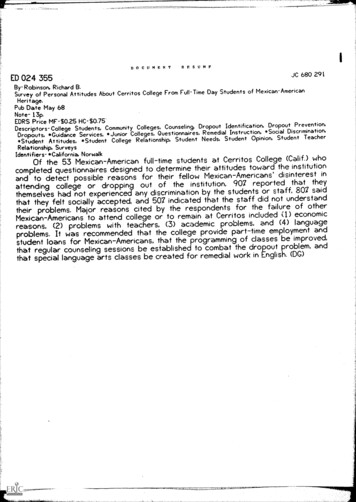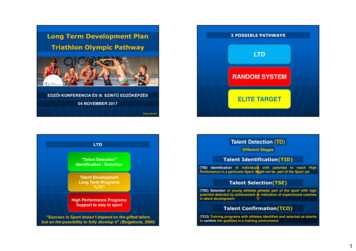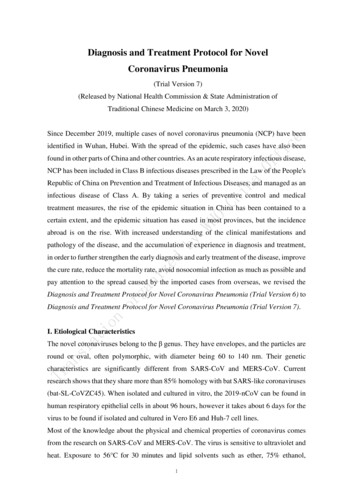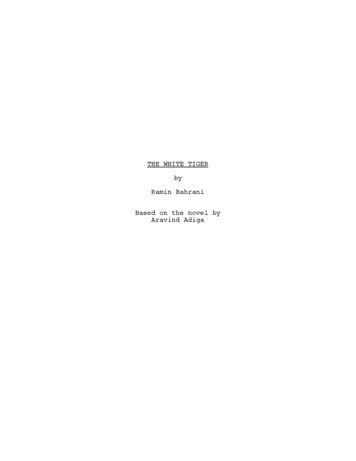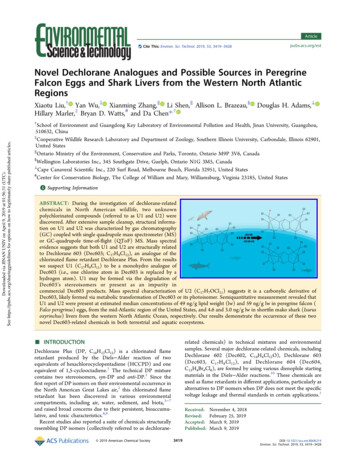
Transcription
ArticleCite This: Environ. Sci. Technol. 2019, 53, 3419 3428pubs.acs.org/estNovel Dechlorane Analogues and Possible Sources in PeregrineFalcon Eggs and Shark Livers from the Western North AtlanticRegionsXiaotu Liu,† Yan Wu,‡ Xianming Zhang, Li Shen, Allison L. Brazeau,§ Douglas H. Adams, Hillary Marler,‡ Bryan D. Watts,# and Da Chen*,†Downloaded via JINAN UNIV on April 9, 2019 at 01:56:31 (UTC).See https://pubs.acs.org/sharingguidelines for options on how to legitimately share published articles.†School of Environment and Guangdong Key Laboratory of Environmental Pollution and Health, Jinan University, Guangzhou,510632, China‡Cooperative Wildlife Research Laboratory and Department of Zoology, Southern Illinois University, Carbondale, Illinois 62901,United States Ontario Ministry of the Environment, Conservation and Parks, Toronto, Ontario M9P 3V6, Canada§Wellington Laboratories Inc., 345 Southgate Drive, Guelph, Ontario N1G 3M5, Canada Cape Canaveral Scientific Inc., 220 Surf Road, Melbourne Beach, Florida 32951, United States#Center for Conservation Biology, The College of William and Mary, Williamsburg, Virginia 23185, United StatesS Supporting Information*ABSTRACT: During the investigation of dechlorane-relatedchemicals in North American wildlife, two unknownpolychlorinated compounds (referred to as U1 and U2) werediscovered. After extensive sample cleanup, structural information on U1 and U2 was characterized by gas chromatography(GC) coupled with single quadrupole mass spectrometer (MS)or GC-quadrupole time-of-flight (QToF) MS. Mass spectralevidence suggests that both U1 and U2 are structurally relatedto Dechlorane 603 (Dec603; C17H8Cl12), an analogue of thechlorinated flame retardant Dechlorane Plus. From the resultswe suspect U1 (C17H9Cl11) to be a monohydro analogue ofDec603 (i.e., one chlorine atom in Dec603 is replaced by ahydrogen atom). U1 may be formed via the degradation ofDec603’s stereoisomers or present as an impurity incommercial Dec603 products. Mass spectral characterization of U2 (C17H7OCl11) suggests it is a carbonylic derivative ofDec603, likely formed via metabolic transformation of Dec603 or its photoisomer. Semiquantitative measurement revealed thatU1 and U2 were present at estimated median concentrations of 49 ng/g lipid weight (lw) and 59 ng/g lw in peregrine falcon (Falco peregrinus) eggs, from the mid-Atlantic region of the United States, and 4.6 and 3.0 ng/g lw in shortfin mako shark (Isurusoxyrinchus) livers from the western North Atlantic Ocean, respectively. Our results demonstrate the occurrence of these twonovel Dec603-related chemicals in both terrestrial and aquatic ecosystems. INTRODUCTIONDechlorane Plus (DP, C18H12Cl12) is a chlorinated flameretardant produced by the Diels Alder reaction of twoequivalents of hexachlorocyclopentadiene (HCCPD) and oneequivalent of 1,5-cyclooctadiene.1 The technical DP mixturecontains two stereoisomers, syn-DP and anti-DP.1 Since thefirst report of DP isomers on their environmental occurrence inthe North American Great Lakes air,2 this chlorinated flameretardant has been discovered in various environmentalcompartments, including air, water, sediment, and biota,3 7and raised broad concerns due to their persistent, bioaccumulative, and toxic characteristics.8,9Recent studies also reported a suite of chemicals structurallyresembling DP isomers (collectively referred to as dechlorane 2019 American Chemical Societyrelated chemicals) in technical mixtures and environmentalsamples. Several major dechlorane-related chemicals, includingDechlorane 602 (Dec602, C14H4Cl12O), Dechlorane 603(Dec603, C 17 H 8 Cl 12 ), and Dechlorane 604 (Dec604,C13H4Br4Cl6), are formed by using various dienophile startingmaterials in the Diels Alder reactions.10 These chemicals areused as flame retardants in different applications, particularly asalternatives to DP isomers when DP does not meet the specificvoltage leakage and thermal standards in certain 3419November 4, 2018February 25, 2019March 9, 2019March 9, 2019DOI: 10.1021/acs.est.8b06214Environ. Sci. Technol. 2019, 53, 3419 3428
ArticleEnvironmental Science & TechnologySamples. Addled peregrine falcon (Falco peregrinus) eggs(n 15) were collected during the period from 2013 to 2014from the Chesapeake Bay, United States (U.S.) by avianecologists from the Center for Conservation Biology, TheCollege of William and Mary. Shortfin mako sharks (n 25)were sampled by scientists from the Cape Canaveral ScientificInc. using hooked gear from offshore waters ranging fromsouthern Maine to New York from 2008 to 2014. Liver tissueswere removed from each shark. For qualitative characterizationof unknown dechlorane analogues, a composite per species wasprepared by pooling and homogenizing an aliquot of eachindividual samples with approximately equal weights, whereassemiquantitative measurements were conducted on individualsamples.Sample Treatment. Approximately 15 g of peregrinefalcon egg composite and 1.2 g of shark liver composite wereextracted and processed in five and three replicates (3 and 0.4g each), respectively. Each replicate was ground withdiatomaceous earth and subjected to pressurized fluidextraction (Dionex ASE 350 Accelerated Solvent Extractor,Thermo Scientific, Sunnyvale, CA) with dichloromethane(DCM) at 100 C and 1500 psi. The extract was dehydratedby passing through sodium sulfate and then purified with gelpermeation chromatography (GPC, length 40 cm, diameter 1.5cm) packed with 6 g of styrene divinylbenzene beads in amixture of hexane and DCM (HEX/DCM, 1:1, v/v). After thefirst fraction was eluted with 30 mL of HEX/DCM (1:1, v/v)and discarded, the second fraction was eluted with 60 mL ofHEX/DCM (1:1, v/v) and then concentrated for furthercleanup through a 2 g isolute silica solid phase extraction(SPE) cartridge. After the cartridge was preconditioned with10 mL of HEX, the sample was loaded and the cartridge waswashed with 3 mL of HEX. Target compounds were theneluted out with 11 mL of a HEX/DCM mixture (6:4, v/v).The final extracts of five replicates of falcon egg composite orthree replicates of shark liver composite were combined byspecies and fractionated through a 7 g silica gel column (250 11 mm i.d.) in order to further remove other potentialinterferences (e.g., dechlorane analogues and other chlorinatedsubstances) from the fraction containing two unknownchemicals for better mass spectral characterization. After thecombined extract was loaded, the silica gel column was elutedwith 30 mL of HEX, 30 mL of HEX/DCM (8:2, v/v), andfollowed by 30 mL of HEX/DCM (1:1, v/v). The eluent wascollected into nine fractions (10 mL of each fraction). The twounknown analytes were found to be present in fractions 5 7only. These three fractions were combined, concentratedunder nitrogen, and transferred to a GC vial.To estimate the concentrations of the two unknowncompounds (referred to as U1 and U2), approximately 0.5 1 g of individual peregrine egg or 0.2 0.5 g of individual sharkliver was ground with diatomaceous earth, spiked withsurrogate standard, and then extracted with ASE. A proceduralblank was processed along with each set of seven samples.After running the mixture through sodium sulfate to removemoisture, the extract was gravimetrically tested for lipidcontent by using 10% of the extract. The remaining extractwas cleaned through GPC and then SPE, using the sameprocedures (except the cleanup through a 7 g silica gelcolumn) that were applied to composite samples as mentionedbefore. The final extract was concentrated to around 200 μLand spiked with internal standard FBDE-154.In addition to these major dechlorane analogues, other relatedchemicals were also reported in the environment. Some ofthem are impurities present in side reactions or incompletesynthesis of DP, such as 4-vinylcyclohexene DP (VCH-DP)and 1,3- and 1,5-Dechlorane Plus monoadducts (DPMA).11The others are dechlorination products of DP isomers, such asmonodechlorinated and didechlorinated DP (Cl11-DP andCl10-DP)12,13 or debromination products of Dec604, such asBr-Dec604 and Br2-Dec604.14 Several dechlorane-relatedanalogues, including Dec602, Dec603, and Dec604 Component B (Dec604CB), were frequently detected in air, sediment,and fish from the Great Lakes of North America, fish from theSt. Lawrence River (Canada), Illinois (U.S.) rivers, andLiaodong Bay (China), Franciscana dolphins (Pontoporiablainvillei) from Brazil, bottlenose dolphins (Tursiops truncatus) and common dolphins (Delphinus delphis) from SouthernEuropean waters, bobcats (Lynx rufus) from the midwesternU.S., and peregrine falcon (Falco peregrinus) eggs from Canadaand Spain.10,12,15 19 These findings demonstrate globaldistribution of dechlorane-related chemicals and their substantial bioaccumulation potencies.1We recently determined a suite of known dechloraneanalogues in peregrine falcon eggs from the mid-AtlanticUnited States (U.S.) and livers of shortfin mako sharks (Isurusoxyrinchus) from the western North Atlantic Ocean. Duringthe instrumental analysis using gas chromatography-singlequadrupole mass spectrometry under electron-capture negativeionization or electron impact mode (GC-ECNIqMS or GCEIqMS), two unknown peaks were frequently detected in eggor liver extracts. Mass spectral analyses suggest that the twounknowns are polychlorinated and their fragmentation patternspartially resemble those of major dechlorane analogues.However, neither of the two unknown peaks fully matcheswith any known dechlorane analogues on both the retentiontime and mass fragmentation patterns. We suspected thesepeaks represent novel dechlorane analogues or the derivativesrelated to known dechlorane analogues. Therefore, the presentstudy was subsequently undertaken to (1) characterize thesetwo novel dechlorane-related substances using different massspectrometers and ionization sources and discuss theirpotential sources and (2) estimate their concentrations inperegrine falcon eggs and shortfin mako shark livers andcompare them with other major dechlorane analogues found inthese two species. Our results broaden the current knowledgeon the environmental occurrence, fate, and bioaccumulation ofthe dechlorane family of flame retardants. MATERIALS AND METHODSChemicals and Reagents. Reference standards ofdechlorane analogues, including Dec601, Dec602, Dec603,Dec604, Dec604CB, anti-Cl11-DP, anti-Cl10-DP, ChlordenePlus (Cplus), and anti- and syn-DP, were purchased fromWellington Laboratories (Guelph, ON, Canada). Surrogatestandard 4′-fluoro-2,3,3′,4,5,6-hexabromodiphenyl ether(FBDE-160) and internal standard 3′-fluoro-2,2′,4,4′,5,6′hexabromodiphenyl ether (FBDE-154) were also purchasedfrom Wellington Laboratories. Styrene divinylbenzene beads(3% cross-linkage, 40 80 μm bead size, 2000 MW limit) andisolute silica sorbent were purchased from Bio-Rad (Hercules,CA) and Biotage Inc. (Charlotte, NC), respectively. Solventsused were high performance liquid chromatography (HPLC)grade (Fisher Scientific, Hanover Park, IL).3420DOI: 10.1021/acs.est.8b06214Environ. Sci. Technol. 2019, 53, 3419 3428
ArticleEnvironmental Science & TechnologyFigure 1. Gas chromatography-quadrupole mass spectrometry (electron-capture negative ionization mode) mass chromatograms of: (a and b) U1and U2 in peregrine falcon egg composite extract; (b) a mixture of dechlorane analogue reference standards, including Dec601, Dec602, Dec603,and Dec604; and (d) a reference standard mixture of syn-DP, anti-DP, and anti-Cl11-DP. It is noted that the first eluting peak on Figure 1arepresents a fragment ion of Dec603 at m/z 602.flight mass spectrometer equipped with atmospheric pressureionization for GC (GC-APCI-HRqToFMS) (Waters Corp.,Milford, MA). The mass resolution is around 20000 fwhm (fullwidth at half-maximum) at m/z 600. The APCI sourcetemperature was set at 125 C, and the cone gas flow andcorona current were 175 L/h and 3.0 μA, respectively. The GCinjector was operated in splitless mode at 280 C. GCseparation was conducted with a 15 m DB-5HT column (0.25mm i.d., 0.1 μm film thickness, J &W Scientific, Agilent Tech.)with oven temperature held initially at 120 C for 1 min,ramped to 245 C at 20 C/min, increased to 280 C at 10 C/min, and finally increased to 320 C at 40 C/min (heldfor 3 min). Temperatures of the transfer line and source wereset as 330 and 125 C, respectively. Full scan (scan range 100 1000 m/z) and tandem MS spectra (collision energy rampedfrom 10 to 40 eV) were gained for the two unknown peaks.The ions passing through Q1 in the tandem MS experimentwere m/z 601.8 and 615.8 for U1 and U2, respectively.Instrumental Analysis. Characterization of U1 and U2 incomposite extracts was first conducted on an Agilent 7890BGC (Agilent Technologies, Palo Alto, CA) coupled with anAgilent 5977A low resolution, single quadrupole mass analyzerin both ECNI and EI ionization modes. The GC was equippedwith a 30 m HP-5MS column (0.25 mm i.d., 0.25 μm, J &WScientific, Agilent Tech.). The GC injector was operated in apulsed-splitless mode and held at 260 C. Initial oventemperature was held at 80 C for 3 min, ramped to 150 Cat 10 C/min, and finally increased to 300 C at 5 C/min(held for 10 min). Full scan (scan range 30 950 m/z) massspectra were generated for the unknown analytes under EI (ionsource 230 C) or ECNI (ion source 200 C) modes. Theheated transfer line temperature and quadrupole temperaturewere set as 280 and 150 C, respectively.To gain in-depth structural information on U1 and U2, wealso analyzed the composites using a system of Agilent 7890BGC coupled with a Waters Xevo G2-XS quadrupole time-of3421DOI: 10.1021/acs.est.8b06214Environ. Sci. Technol. 2019, 53, 3419 3428
ArticleEnvironmental Science & TechnologyFigure 2. Atmospheric pressure GC source (positive) quadrupole time-of-flight tandem mass spectra of Dec603 in the reference standard (a) andU1 and U2 in the peregrine falcon egg composite extract (b and c).Concentrations of
U1 and U2 were present at estimated median concentrations of 49 ng/g lipid weight (lw) and 59 ng/g lw in peregrine falcon (Falco peregrinus) eggs, from the mid-Atlantic region of the United States, and 4.6 and 3.0 ng/g lw in shortfin mako shark (Isurus oxyrinchus) livers from the western North Atlantic Ocean, respectively. Our results demonstrate the occurrence of these two novel Dec603 .
